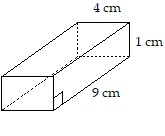Solve the problem.Find the work done by a force of 17i (newtons) in moving an object along a line from the origin to the point  (distance in meters).
(distance in meters).
A. 36.06 J
B. 17 J
J
C. 51 J
J
D. 51 J
Answer: D
You might also like to view...
Find the volume of the solid. Use  for ?.
for ?. 
A. 14 cu cm B. 36 cu cm C. 4 cu cm D. 108 cu cm
Answer each question appropriately.If differentiable functions y = F(x) and y = G(x) both solve the initial value problem 
 on an interval I, must
on an interval I, must  for every x in I? Justify the answer.
for every x in I? Justify the answer.
A. F(x) = G(x) for every x in I because integrating f(x) results in one unique function. B. F(x) and G(x) are not unique. There are infinitely many functions that solve the initial value problem. When solving the problem there is an integration constant C that can be any value. F(x) and G(x) could each have a different constant term. C. There is not enough information given to determine if F(x) = G(x). D. F(x) = G(x) for every x in I because when given an initial condition, we can find the integration constant when integrating f(x). Therefore, the particular solution to the initial value problem is unique.
Multiply. Do not simplify. ?
? 
A. 
B. 
C. 
D. 
Find the distance between the points (4, -5) and (9, 0). Round the answer to the nearest tenth. ?
A. 7.1 B. 7.4 C. 7.3 D. 7.5 E. 6.9